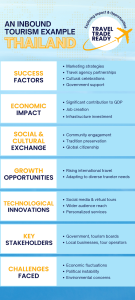An Inbound Tourism Example: Exploring Impact & Opportunities
Inbound tourism refers to the travel of non-residents to a country, significantly impacting local economies, cultures, and environments. As globalization continues to evolve, understanding the dynamics of inbound tourism becomes crucial for stakeholders. This article will delve into an inbound tourism example, exploring its impacts and uncovering potential opportunities for growth.
Understanding Inbound Tourism
Inbound tourism plays a vital role in the global economy. It generates revenue, creates jobs, and fosters cultural exchange, making it an essential sector for many countries. By attracting visitors, destinations can enhance their international reputation and foster sustainable development. To clarify, an inbound tourism definition with example entails visitors coming into a country from abroad for leisure, business, or other purposes, such as tourists traveling to France from the United States.
In our inbound tourism example, we will examine a specific case study, illustrating the various facets of this vibrant industry.
Inbound Tourism Example: Thailand
Let’s consider Thailand, a prime of successful inbound tourism definition with example. Known for its stunning landscapes and rich cultural heritage, this destination has become a magnet for international travelers. The unique blend of attractions, including historical sites, natural wonders, and local festivals, draws millions of visitors annually.

Success Factors
Several key factors contribute to the success of this inbound tourism example. Effective marketing strategies, including digital campaigns and partnerships to promote travel and tourism with travel agencies, have significantly raised awareness. Additionally, the celebration of local culture through festivals and events enhances the visitor experience, creating memorable moments that encourage repeat visits.
Government initiatives can play a crucial role in supporting inbound tourism. Through funding and grants aimed at developing tourism infrastructure, authorities can create a conducive environment for growth. This policy support is vital for sustaining long-term success in the industry.
Economic Impact of Inbound Tourism
The economic benefits of inbound tourism are profound. For Thailand, tourism accounts for a substantial portion of the local GDP, creating thousands of jobs across various sectors, from hospitality to transportation. These economic gains extend beyond immediate revenues, fostering long-term development and investment in infrastructure.
Social and Cultural Exchange
Beyond economics, inbound tourism fosters social and cultural exchange. Visitors engage with local communities, leading to a mutual understanding that enriches both parties. This cultural interaction not only preserves local traditions but also promotes a sense of global citizenship.
Opportunities for Growth
As we explore opportunities within the inbound tourism example, we see several growth trends. Recent statistics show a surge in international travel, particularly from emerging markets. This presents a unique opportunity for destinations to adapt their offerings to cater to diverse traveler needs.
Technological Innovations
Technological advancements are also reshaping the inbound tourism landscape. The integration of technology in marketing, such as social media campaigns and virtual tours, allows destinations to reach broader audiences. Such innovations enhance the visitor experience, providing personalized services that cater to individual preferences.
Key Stakeholders in Inbound Tourism
Several key stakeholders contribute to the success example of inbound tourism. Government agencies regulate and promote tourism, while local tourism boards implement marketing strategies to attract visitors. Partnerships between local businesses and tour operators can also lead to tailored experiences, enhancing visitor satisfaction.
Challenges Faced
Despite its numerous benefits, inbound tourism is not without challenges. Economic fluctuations can affect travel patterns, while political instability may deter potential visitors. Environmental concerns, such as over-tourism, also pose significant threats to sustainability. Addressing these challenges requires coordinated efforts among stakeholders, ensuring the tourism sector remains resilient.
Conclusion
The inbound tourism example of Thailand illustrates the vast potential of this sector. Through effective marketing, cultural exchange, and government support, destinations can harness the economic benefits while promoting sustainability. As the tourism landscape continues to evolve, stakeholders must remain proactive in adapting to new trends and challenges.
The future of inbound tourism holds exciting opportunities for growth, and collaboration among all parties is essential for maximizing its benefits. Additionally, exploring examples of inbound tourism can provide further insights into successful strategies and practices. By understanding and leveraging the nuances of inbound tourism, destinations can thrive in an increasingly interconnected world.


